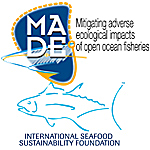The increasing use of these drifting man-made FADs in the skipjack fishery may have modified tuna habitat and raised questions about their potential effects on the biology and, hence, reproductive potential of the species. Therefore, this work aims to first investigate the skipjack tuna bioenergetics in relation to its maturation, and then to evaluate the potential effect of its associative behaviour (FADs vs. FSCs) on the energy allocation strategy and body condition. A total of 673 individuals were examined histologically for reproduction studies. Tissue sample collection (gonads, liver and white muscle) was done on 103 females for biochemical analysis. Tissue lipid class composition (i.e., SE- WE, KET, TAG, ST, AMPL and PL) was determined with an Iatroscan MK-6s (Iatron lab, Tokyo, Japan) after being extracted by the modified Folch method.
Total lipid concentrations were 14.2±8.0 µg/mg, 17.4±10.6 µg/mg and 5.3±4.7 µg/mg in gonads, liver and muscle of skipjacks, respectively. SE-WE and TAG results in gonads were highly variable in relation with the gonad maturation stages; indeed, they contributed to 32.4% of total lipids in immature females, and to 60.2% in individuals being in spawning capable phase. While tuna white muscle is known to represent the main energy (or lipid) reserves, our results didn't highlight any relationship between total lipids or lipid class distribution in muscle and the gonad maturation stages.

 PDF version
PDF version
